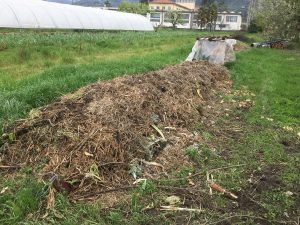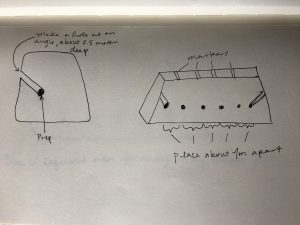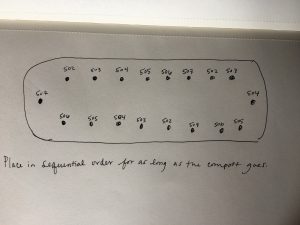Compost has been an important part of organic farming forever. It’s a craft that can take a long time to master, one might think of it as a very long experiment. There are many suggestions on different ways to compost, some say the ideal compost is to do a layer of dead plant matter then a layer of manure followed by a layer of green plants, add some straw in there and repeat, other say to just throw all of these elements together without regard to structure and call it a day, and there is even a compost tea that is an option. Between the unorganized pile and the neat layers, there is a commonality, which is to pay attention to the amount of dry plants to green plants ratio. Federico does his compost in layers, and was taught by his very first WWOOFer who he says was a compost master.
If there is too much green plant matter it can cause the pile to get too hot, which is not beneficial to microbial growth. Initially the compost heap will be between 45 degrees Celsius and 50 degrees Celsius (113-122 degrees Fahrenheit), and after a week or so the heap will slowly cool down which will make desirable environment for fungus and microorganisms to make this their new home.
When a healthy compost has been made the worms will come, they are essential to transforming the pile from organic material to humus by eating and mixing the contents. The compost heap should be monitored to make sure that the temperature does not rise above 50 degrees Celsius (122 degrees Fahrenheit) to ensure that the happy decomposers don’t vacate the premise. If you do notice the temperature rising add some water to the top of the heap to cool it down, but be careful not to add to much because the minerals within the heap will likely leach out into the surrounding soil. It’s probably a good idea to take notes on how much of each substance you’ve added to the heap to avoid over heating in the future. Adding too much fresh manure, and the type of manure added (poultry and horse manure creates the most heat) has a great effect on the temperature. Using older manure might be a good option because the heating potential is less than that of fresh manure.
Once the compost’s form is established it’s time to add the preparations. The preparations will help speed the process along and add more nutrients to the heap, which will be added to the soil where crops are planted, in turn making a healthier plant. Below is an illustration of how the preparations are to be placed in the compost pile:
And there you have it, a biodynamic compost heap! Let the humus rich, mycroryze party commence!


